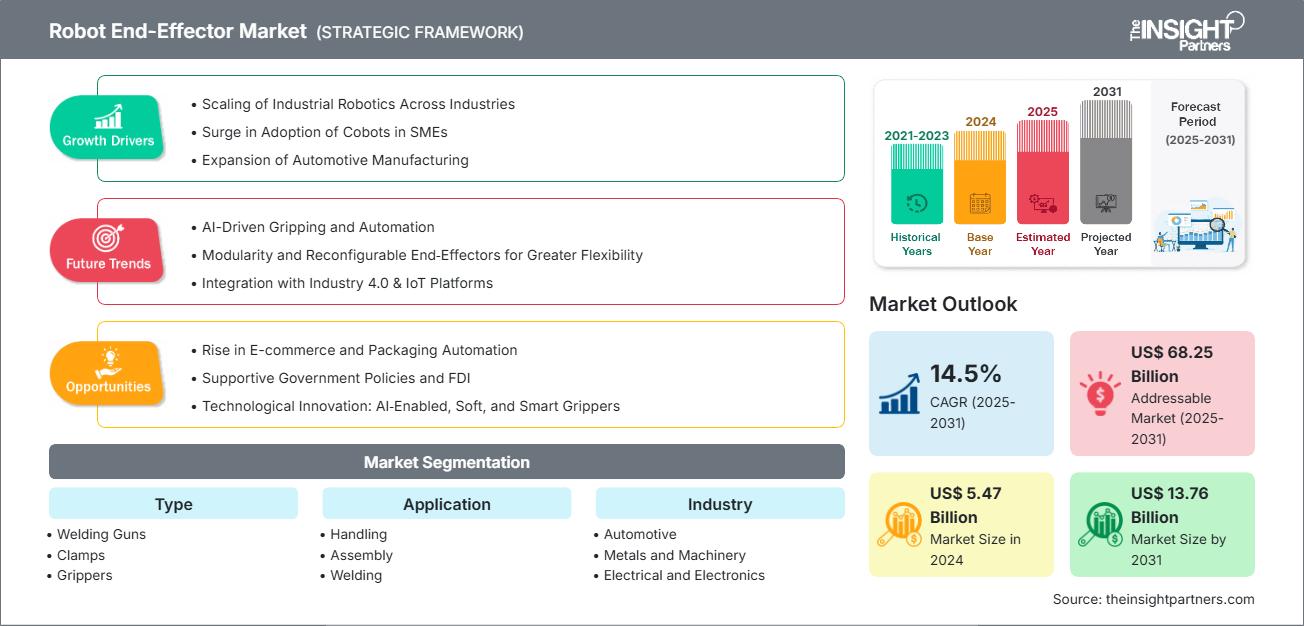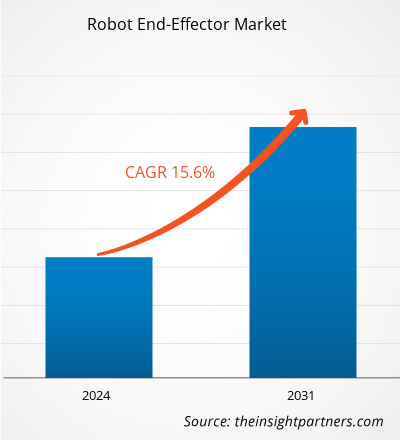机器人末端执行器市场规模预计在 2024 年达到 54.7 亿美元,预计到 2031 年将达到 137.6 亿美元。预计在 2025-2031 年期间,机器人末端执行器市场规模的复合年增长率将达到 14.5%。
机器人末端执行器市场分析
随着工业自动化程度的提高、机器人技术的进步以及协作机器人 (cobot) 在工作场所的使用,机器人末端执行器市场正在稳步增长。越来越多的应用需要不同类型的末端执行器,这些末端执行器必须灵活、高精度且高度专用。对各种末端执行器的需求不断增长,尤其是在汽车、电子和物流领域,这促使制造商大力投资智能夹爪、真空吸盘和工具快换装置。该领域的技术进步,加上传感器和基于人工智能的控制的更多集成,扩展了末端执行器的功能,例如自适应抓取和抓取性能的实时反馈。由于模块化和可定制末端执行器解决方案的趋势日益增长,在主要预测期内,该行业将拥有非常强劲的增长机会。
机器人末端执行器市场概况
末端执行器是直接作用于机器人系统工件(例如夹持器、焊枪、真空吸盘)的装置(或工具),有助于实现许多不同领域的自动化方法。随着企业追求更高的灵活性和效率,对多功能智能末端执行器的需求日益增长。末端执行器使机器人能够执行需要更高复杂性、准确性和兼容性的任务,从而不受限制地与人类协同工作。所有末端执行器的采用率都相当高,尤其是在汽车制造、电子装配、仓储和医疗保健领域。随着工业4.0的发展,智能互联末端执行器产品不断涌现,这些产品旨在提高生产力,同时减少停机时间。
您可以免费定制任何报告,包括本报告的部分内容、国家级分析、Excel 数据包,以及为初创企业和大学提供优惠和折扣
机器人末端执行器市场:战略洞察

-
获取此报告的顶级关键市场趋势。此免费样品将包括数据分析,从市场趋势到估计和预测。
机器人末端执行器市场驱动因素和机遇
市场驱动因素:
-
工业自动化领域的增长
随着各行各业纷纷尝试自动化以提高生产力,机器人末端执行器正逐渐应用于焊接、装配和物料搬运等工业领域。制造业和物流业智能工厂的兴起,与先进末端执行器技术的需求增长相呼应,这些技术旨在提升性能、速度和生产力。 -
协作机器人(Cobots)的增加
协作机器人要求末端执行器轻便、安全且功能多样。协作机器人在大多数中小企业 (SME) 以及非传统行业的应用日益广泛,这使得对更易于使用、更灵活的末端执行器的需求日益增长,这些末端执行器应包含内置传感器和柔顺性。末端执行器功能多样,适用于更广泛的场景,从而在各种工作环境中的使用率也随之增加。 -
定制化和多功能性需求增长
制造商对定制末端执行器的需求日益增长,这些末端执行器能够与不同形状、材料和易碎部件配合使用。电子、食品和医疗保健行业对定制末端执行器的需求日益增长,以提高效率并加快作业切换速度。多功能末端执行器解决方案能够快速切换作业,可以彻底改变某些生产领域,在这些领域,定制化可能成为竞争激烈的环境中行业增长的关键驱动力。
市场机会:
-
拓展新兴市场
亚洲、拉丁美洲和非洲的新兴市场为末端执行器的应用提供了机遇。从区域来看,随着这些市场投入资源用于自动化以提高生产力,当地产业整合机器人技术的潜力很大程度上尚未得到挖掘。
-
人工智能与智能传感器的集成
将人工智能和先进的传感技术集成到末端执行器中,可以实现自适应抓取、实时决策和错误恢复。这些功能的实现将开拓对精度要求更高的新市场(例如电子和制药行业)。智能末端执行器能够自动适应不同的物体,从而提高效率并减少编程时间和停机时间。
-
电子商务和物流增长
电子商务的快速发展增加了仓库和配送中心对自动化的需求。用于取放、分拣和包装操作的末端执行器能够满足消费者对及时交付和订单准确性的期望。这为提供可扩展、快速且可靠的末端执行器系统的供应商提供了一个高增长潜力市场。
市场趋势:
-
模块化和即插即用设计
模块化末端执行器已成为众多应用的明显趋势,旨在简化安装、升级或在不同应用之间切换。即插即用的末端执行器设计缩短了集成时间,并降低了培训需求。对于追求灵活性并快速实现跨生产线价值的制造商而言,模块化和即插即用的末端执行器是理想之选。
-
关于人机协作
末端执行器正日益发展,旨在为人类工作者和机器人之间提供安全直观的交互。柔性夹爪、柔性机构以及带有力反馈的接口可以改善人机协作。这种人机协作趋势增强了协作机器人的扩展,并涵盖了在结构化程度较低、以人为中心的环境中更广泛的机器人部署机会。
-
微型化以实现高精度任务
在电子和医疗器械行业,处理小型易碎部件的需求推动了微型末端执行器的设计。微型末端执行器为需要大幅度移动的应用(例如微装配、外科手术和其他精细操作任务)提供精确性和灵活性,同时顺应了小型化和高性能自动化的趋势。
机器人末端执行器市场报告细分分析
机器人末端执行器市场细分为不同的细分领域,以便更清晰地了解其工作原理、增长潜力和最新趋势。以下是行业报告中使用的标准细分方法:
按类型:
-
焊枪
作为机器人末端执行器,焊枪在汽车和重型机械领域有着广泛的应用。它们能够在装配线上实现高精度焊接,最终提高最终产品质量并降低人工成本。由于金属加工工艺自动化程度的提高以及对高速焊接一致性的需求,焊枪的普及度日益提升。 -
夹持器
夹持器广泛应用于多种功能,包括拾放应用、物流、包装和装配线应用。夹持器使机器人能够操控各种形状和尺寸的物体,从而提高生产效率。随着电子商务和仓库自动化的发展,对夹持器的需求日益增长,以满足对速度、精度和有限人工操作要求较高的任务。 -
工具更换器
由于换刀装置使机器人能够自动切换不同的工具,从而扩展了机器人的灵活性。换刀装置可以减少停机时间,并提高航空航天、电子和汽车等领域机器人系统的灵活性。随着制造业向更加灵活的自动化系统转型,换刀装置正日益受到青睐。 -
夹具
夹具用于在加工、焊接或装配过程中安全可靠地固定工件。在注重稳定性和安全性的精密操作中,夹具是重要的末端执行器。随着自动化制造和数控操作的日益普及,工业领域对机器人夹具的需求也日益增加。 -
吸盘
吸盘通常用于搬运易碎或轻质材料,例如玻璃、塑料或纸张。在一些需要快速安全地搬运材料的行业(例如食品包装和电子产品)中,真空吸力技术尤为重要。由于吸盘不会造成损坏,因此非常适合搬运易碎、轻质产品以及洁净室应用。 -
真空
真空末端执行器目前在包装、仓储和物料搬运行业中广泛用于处理扁平或多孔物体。它们的吸附速度和释放速度都很快。真空末端执行器可实现高速工作流程,这有利于机器人物流应用的日益普及。 -
其他的
另一部分包括专用或混合式末端执行器,专为抛光、喷漆和超声波切割等细分应用而设计。随着工业自动化的不断发展,定制化末端执行器可以开发并适应独特高效的操作流程。
按应用
- 处理
- 集会
- 焊接
- 分配
- 加工
- 其他的
按机器人类型
- 传统机器人
- 协作机器人
按行业
- 汽车
- 电气和电子
- 金属和机械
- 食品和饮料
- 零售和电子商务
- 其他的
按地理位置
- 北美
- 欧洲
- 亚太地区
- 南美洲和中美洲
- 中东和非洲
机器人末端执行器市场区域洞察
Insight Partners 的分析师已详尽阐述了预测期内影响机器人末端执行器市场的区域趋势和因素。本节还讨论了北美、欧洲、亚太地区、中东和非洲以及南美和中美洲的机器人末端执行器市场细分和地理分布。
机器人末端执行器市场报告范围
| 报告属性 | 细节 |
|---|---|
| 2024年的市场规模 | 54.7亿美元 |
| 2031年的市场规模 | 137.6亿美元 |
| 全球复合年增长率(2025-2031) | 14.5% |
| 史料 | 2021-2023 |
| 预测期 | 2025-2031 |
| 涵盖的领域 |
按类型
|
| 覆盖地区和国家 |
北美
|
| 市场领导者和主要公司简介 |
|
机器人末端执行器市场参与者密度:了解其对业务动态的影响
机器人末端执行器市场正在快速增长,这得益于终端用户需求的不断增长,而这些需求的驱动因素包括消费者偏好的演变、技术进步以及对产品优势的认知度的提升。随着需求的增长,企业正在扩展产品线,不断创新以满足消费者需求,并抓住新兴趋势,从而进一步推动市场增长。

- 获取机器人末端执行器市场顶级关键参与者概览
机器人末端执行器市场份额(按地区)分析:随着企业积极投资工业自动化解决方案、采用先进制造技术并将研发资源集中于机器人技术,北美机器人末端执行器市场的增长正在快速加速。随着工业活动的兴起、政府的支持性项目以及低成本制造的推动,亚太地区将经历巨大的增长,从而在整个西半球开启机器人技术的新时代。在目前领先的欧洲市场,其增长主要得益于对研发和创新的投入、安全标准的提高以及几乎所有行业对协作机器人的广泛应用。
机器人末端执行器市场在终端用户采用率和创新方面因地区而异,这取决于自动化的准备程度、劳动力的可用性和动态,以及各自行业领域的发展轨迹和增长情况。以下是各地区市场份额和趋势的摘要:
1. 北美
-
市场份额:
由于早期采用该技术,在全球仍占有较大份额 -
关键驱动因素:
- 大量机器人制造商和集成商
- 在自动化技术领域投入大量研发资金
- 协作机器人在汽车和航空航天领域的应用正在不断扩大。
-
趋势:
专注于高端应用的精密末端执行器和对智能夹持器日益增长的需求。
2.欧洲
-
市场份额:
仍然是一个稳定、成熟的市场 -
关键驱动因素:
- 通过使用协作机器人实现最新自动化,符合规范的安全标准
- 强大的汽车和电气制造基地
- 工业4.0技术的融合。
-
趋势:
电动汽车制造业的激增将增加对焊接和装配末端执行器的需求。
3. 亚太地区
-
市场份额:
全球增长最快的市场。 -
关键驱动因素:
- 快速廉价的制造和健康的工业化速度
- 政府对自动化的干预——“中国制造2025”
- 消费电子和汽车行业蓬勃发展。
-
趋势:
更多地使用多功能和轻量级末端执行器技术来促进灵活的自动化。
4.南美洲和中美洲
-
市场份额:
新兴市场在工业领域的应用日益广泛 -
关键驱动因素:
- 食品饮料和包装行业对自动化的需求不断增长
- 对更廉价劳动力成本替代品的需求
- 国际机器人供应商的活动日益活跃。
-
趋势:
在小规模工业中采用诸如夹具和吸盘之类的基本末端执行器。
5.中东和非洲
-
市场份额:
投资兴趣日益增长的发展中市场 -
关键驱动因素:
- 扩大物流和仓储领域
- 石油天然气自动化和智能基础设施的增长
- 政府在产业多元化方面的举措。
-
趋势:
采矿和公用事业等非传统领域对机器人系统的采用推动了对坚固耐用的末端执行器的需求。
机器人末端执行器市场参与者密度:了解其对业务动态的影响
市场密度高,竞争激烈
由于ABB有限公司、SMC公司和KUKA股份公司等老牌企业的存在,竞争异常激烈。Festo股份公司和德国ZIMMER集团等区域性和利基供应商的加入,也加剧了跨地区的竞争格局。
这种激烈的竞争促使公司通过提供以下产品脱颖而出:
- 市场参与者之间的伙伴关系与合作
- 扩大技术能力的收购策略。
机遇与战略举措
- 智能和人工智能集成末端执行器的介绍
- 向新兴工业市场进行地理扩张
在机器人末端执行器市场运营的主要公司有:
- ABB有限公司 – 瑞士苏黎世
- SMC 公司 – 日本东京
- DESTACO – 美国密歇根州奥本山
- Festo AG and Co. KG – 德国内卡河畔埃斯林根
- Schmalz GmbH – 德国格拉滕
- KUKA AG – 德国奥格斯堡
- Piab AB – 瑞典丹德吕德
- 史陶比尔国际股份公司 – 瑞士普费菲孔
- SCHUNK GmbH and Co. KG – 德国劳芬/内卡
- ZIMMER GROUP GmbH – 德国巴登符腾堡州莱瑙
免责声明:以上列出的公司没有按照任何特定顺序排列。
研究过程中分析的其他公司:
- 安川电机株式会社
- OnRobot
- 韦斯机器人
- IPR机器人
- Shobai Automation Pvt. Ltd.
- Beckhoff 自动化有限公司
- 易格斯有限公司
- autonox 机器人有限公司
机器人末端执行器市场新闻及最新发展
- 达索系统与库卡的合作 达索系统宣布与全球工业自动化和机器人公司库卡达成合作,为制造业提供满足日益增长的机器人和自动化需求的解决方案。通过扩大客户对虚拟孪生技术的使用范围并增强协作能力,达索系统和库卡及其新成立的库卡数字部门,将为企业创造机遇,开发更高效、适应性更强的解决方案,从而实现运营转型。
- Oxipital AI 与 Schmalz 合作 Oxipital AI 与 Schmalz 扩展了在自动化拣选领域的合作。这两家长期合作伙伴表示,他们将把 Oxipital AI 先进的机器视觉检测和拣选技术与 Schmalz 的 mGrip 机器人手指和真空末端工具 (EOAT) 相结合。此次合作预计将带来下一代机器人抓取解决方案,从而提高运营效率,减少对劳动力的依赖,并确保为食品饮料行业及其他行业的终端客户实现一致、安全且盈利的生产。
机器人末端执行器市场报告覆盖范围和交付成果
《机器人末端执行器市场规模及预测(2021-2031)》报告对市场进行了详细分析,涵盖以下领域:
- 机器人末端执行器市场规模以及涵盖范围主要细分市场的全球、区域和国家层面的预测
- 机器人末端执行器市场趋势以及市场动态,例如驱动因素、限制因素和关键机遇
- 详细的 PEST 和 SWOT 分析
- 机器人末端执行器市场分析涵盖主要市场趋势、全球和区域框架、主要参与者、法规和最新市场发展
- 行业格局和竞争分析,涵盖市场集中度、热图分析、知名参与者以及机器人末端执行器市场的最新发展
- 详细的公司简介
- 历史分析(2 年)、基准年、预测(7 年)及复合年增长率
- PEST和SWOT分析
- 市场规模、价值/数量 - 全球、区域、国家
- 行业和竞争格局
- Excel 数据集
近期报告
相关报告
客户评价
购买理由
- 明智的决策
- 了解市场动态
- 竞争分析
- 客户洞察
- 市场预测
- 风险规避
- 战略规划
- 投资论证
- 识别新兴市场
- 优化营销策略
- 提升运营效率
- 顺应监管趋势






















 获取免费样品 - 机器人末端执行器市场
获取免费样品 - 机器人末端执行器市场